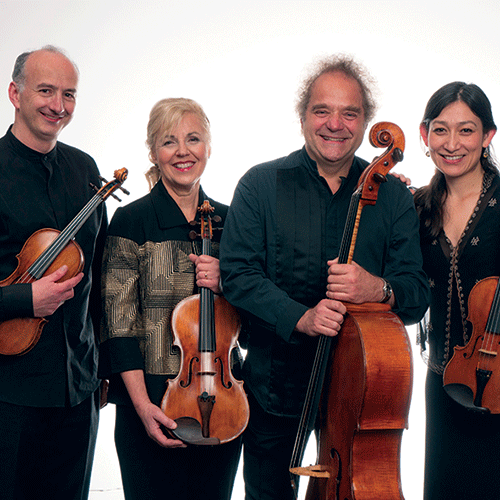Takács Quartet offers exquisite Bartók at the Kennedy Center

The Takács Quartet performed at the Kennedy Center Terrace Theater Tuesday night.
What would the world be like without the Takács Quartet in it? It is an eventuality no fan of this esteemed ensemble, formed in Hungary in 1975, wants to contemplate.
Only one founding member remains, cellist András Fejér, after second violinist Károly Schranz retired last year, to be replaced by Harumi Rhodes. The Fortas Chamber Music Concerts series presented the new formation Tuesday night in the Kennedy Center Terrace Theater.
The good news is that the new second violinist, the daughter of violist Samuel Rhodes (formerly of the Juilliard Quartet), is fitting in quite nicely. At the heart of this program was Bartók’s String Quartet No. 6, the composer’s profoundly sad final work in the genre, completed just before his emigration from his native land during World War II. These six quartets were always the special province of the Takács, and based on this performance they continue to be. (The group returns to the Kennedy Center this October to perform the whole cycle.)
Violist Geraldine Walther set the tone of the piece with a keening, plangent solo to open the performance, a tragic theme that introduces all four movements and concludes the work. The speech-like flexibility of this movement remains engaging and unified, with lively contrapuntal exchanges. Fejér, in his usual almost-hunched position over the cello, seemed the undisputed leader of this piece, glowing in the solo that introduced the second movement.
Rhodes played admirably in some meaty solos in the obsessive march music of the second movement, and all four musicians enlivened the blue-edged “Arietta” of the third movement with folksy slides and bends, as well as energizing the pizzicato sections with playful rhythm. The mood of gloom that settled over the fourth movement like a veil was anguished, with all four musicians searching, questing upwards in probing lines. The fleeting major chord, given to the cello in pizzicato in the closing bars, vanished with bleak finality.
Room for growth remains in the group’s Haydn, another composer long a specialty of the Takács Quartet. The later String Quartet in G Major, Op. 76, no. 1, felt nervous in spots, with the balance and ensemble not quite jelling. The group’s tone was more muscular than golden, and the violinists seemed to rush slightly ahead of the lower strings in the first two movements.
The Menuetto seemed most like the “old” Takács, set not too fast, with first violinist Edward Dusinberre featured in a graceful solo. Minor intonation disagreements also abounded in this quartet, affecting Fejér’s cello in the first movement and the fierce, ardent viola solos of Walther in the final movement.
A critic can only take heart that, at least once in history, a composer dedicated a piece to one of us, as Elgar did with his autumnal Piano Quintet in 1918, honoring the musicologist Ernest Newman. Fejér took the opening cello solos with an elegiac, nostalgic tone, but pianist Garrick Ohlsson attacked the piece in a largely foursquare, uninspiring way, with plenty of crashing volume where needed but not much subtlety.
The triumph of the piece was its gorgeous slow movement, one of those occasions when Elgar’s melodic imagination outdid itself. Viola, cello and piano all took beautiful turns at the yearning serenade melody that pervades the piece, even opening the third movement. The string sound, massed against Ohlsson’s steely touch at the keyboard, was powerful in this swirling Allegro movement, but greater shading of the melodic line would have been welcome as well.
Violinist Benjamin Beilman and pianist Orion Weiss perform on the Fortas series 7:30 p.m. March 21, with music of Mozart, Beethoven, and Schubert, plus a new work by Frederic Rzewski. kennedy-center.org; 202-467-4600